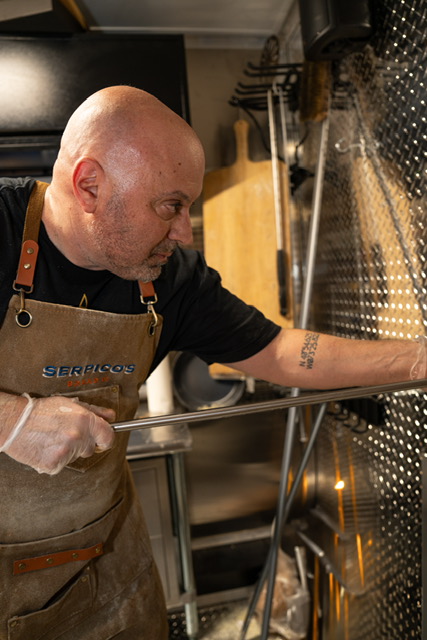WWII Re-Enactment At Airpower Museum
“You are assigned to E Company, 2nd Battalion, 506th Parachute Infantry Regiment, 101st Airborne. You will be handed invasion money in case you need to bribe, steal or cheat for information. Do not use this bribe money for tonight’s poker game; you will need this in case you get into trouble, for a bribe.
“If you haven’t signed up for G.I. Life Insurance, very important, $10,000 that will go to your parents or to your wife in case you don’t make it back. Two years ago every one of you volunteered for this unit. You will remember this day for the rest of your life because once you do your first airborne drop; you will never be the same again.
“Enemy forces have had four years to build up their defenses, hardened defensive structures. The weather, a full moon tonight, it’s outstanding for paratroopers. Fog over the ground at the drop zone, though once you get on the ground, you will have excellent visibility.
“Now have a look at this map, this point here, here and here indicates flooding. This is Utah Beach. Jump Zone Charlie is where we want to drop. Take notice of the bridges, the towns and the crossroads are the choke points, very strategically, these two causeways are the only in-and-out to the beach entry. They wanted it that way,” explained the mission commander.
A soldiers’ briefing for modern day war or a scene from a WWII history documentary? Neither, it’s the briefing given to guest passengers who took part in the Labor Day WWII re-enactment flights and museum displays at the American Airpower Museum in East Farmingdale, delivered by a team of living historians who recreate the mission and the really make guests believe they are embarking on a real combat mission.
Dozens of guest passengers took part in the simulations, gearing up and boarding the C-47 Thunderbolt, and other active and static aircraft like the B-17 Flying Fortress, the B-24 Liberator, and the P-51 Mustang among others.
One of the guest passengers was Anton Community Newspapers’ own Howard Swengler, an advertising representative who embarked on the experience of a lifetime with his son-in-law Brian Stellato who was able to photograph and take video of the whole “mission”.
Upon arrival, Swengler and nine other “recruits” were ushered in the gear room where they dressed in flack jackets, hard helmets and simulated parachutes. They were each given the identity of a soldier who served in WWII and had been assigned to one of the airborne units. Their identity and fate was concealed until the flight returned from the Long Island skies. It was then that they were able to take the ID card out of their jacket pocket to see what had become of them during or after the war.
Swengler was assigned the identity of Army Private Richard Bray. Bray was assigned to E Company, 2nd Battalion, 506th Parachute Infantry Regiment, 101st Airborne, best known as the “Screaming Eagles,” which the HBO miniseries Band of Brothers, from the book by the same name by Stephen Ambrose, is based on. The unit was active from 1942 to 1945. Bray was killed in action in France in 1944.
After the “soldiers” were dressed, they moved into the “Ready Room” where soldiers are typically briefed on the mission they are about to deploy on.
Swengler and the other eight passengers were given some basic procedures and flight instructions; once onboard they were instructed to buckle in for taxiing and take-off. Three licensed paratroopers were also onboard to assist with the flight demonstration.
Once in the air, the guest passengers were allowed to unbuckle and move about the cabin. They were each invited into the cockpit and were able to take turns at the navigator’s table. Then the simulated “jump” was activated. A loud buzzer sounded to indicate that it was time to “jump.” They each took turns pretending to make jump preparations, using hand signals to communicate with the jumpmaster when to wait, or go. It was loud aboard the plane, just as it had been during WWII; if soldiers were not paying attention to the exact hand signals, communicating when to execute the jump, they might miss their target or delay the mission significantly. The sequence of commands would be: stand up—hook up to the static line—physical equipment check—sound off to confirm all “jumpers” are ready to jump.
To simulate briefing the soldiers for their mission, the briefing commander said, “In most cases you will need to be out of that plane in 30 seconds or less because the further you spread out in the jump line, the further apart you will all land when you reach the ground.
“There will be a lot of you guys getting sick on the plane, it’ll be hot; some will be smoking a million cigarettes. You won’t be able to wait to get out of that plane.
“Once over France the plane will take on a lot of anti-aircraft fire; a lot of the pilots are brand new; it’s their first combat operation, they will have to do a lot of evasive maneuvering, causing them to go all over the place. Some guys may be dropped in the channel, where they will drown because their equipment is too heavy. Some soldiers will be dropped too low and their ’chutes won’t deploy, causing them to splatter on the ground; others will be dropped miles away from their target, hence the ‘Longest Day’ in the story of the Band of Brothers, because no one knew where they were at or where they were supposed to be.”
The average soldier was carrying 135 to 160 extra pounds of gear when they jumped into Normandy when they hit the ground. They dropped the parachutes, about 45 pounds of weight relieved. Then they dropped the remaining extra weight from guns and gear to be able to move out once on the ground.
Once back on the ground, Swengler immediately told Anton News, “It was phenomenal; the best thing about it was getting off the ground, you don’t even feel it.” He explained that it was uncomfortably hot inside, but they were able to move around a little bit once in flight and check out the different areas of the cabin and cockpit.
He was impressed by the re-enactment of the ‘living historians’ who acted their roles, and the condition of the plane. “The only things that I know about World War II are things that I have learned from movies and I am so amazed, like how did those guys [WWII soldiers] remember all of the instructions?” The plane ascended to 1,500 feet and circled down to Jones Beach and returned back to East Farmingdale.
For regular events such as this one, visit the East Farmingdale’s American Airpower Museum website at http://www. americanairpowermuseum.com/. Additional photos and video footage from Swengler’s flight can be seen at http://www.anton news.com/.


































